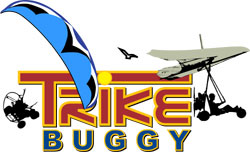

Birth of the 4-Stroker
Terry started experimenting with the heavier 4-stroke motors for a couple of reasons. First, is the seemingly acceptable, yet challenging fact that just about all of the 2-stroke paramotors on the market have reliability issues. While most work well most of the time (if you keep on top of them), they can surprise the pilot with a sudden stop, where the motor simply quits, causing a forced landing. In order to foot launch, we need the increased power-to-weight ratio that these 2-stroke motors offer, but when using a PPG Trike, we can now use a heavier, more reliable power plant since we don't have to carry it on our backs. This has opened up new possibilities in engines, including 4-strokes, propane powered motors and electric engine alternatives. Terry developed and now makes the frame, cage and redrive hubs for the 4-Stroke Thumper, as well as his own CheapTrike TwinSpar Trike that we also offer for sale on our sister site, AmericanParagliding.com From Terry Lutke:"In PPG we have become accustomed to think in terms of a couple hundred hours between major engine maintenance problems. So far with the 4-stroke, I have done zero engine/redrive maintenance other than 1 oil & filter change; extremely low maintenance is the 4-stroke theme I like to push." "In spite of having to deal with the extra weight of the 4-stroke and heavier structure, I have become spoiled by the fly-it-and-forget-it engine and redrive. The Thumper's redrive, belt and engine are designed to mirror industrial standards (btw, properly designed industrial belt drives are designed for 10,000 hrs use between maintenance cycles). Other than minding oil level and oil change intervals, the engine needs nothing, and I think it's possible that the AXtriple belt could last for years without needing to be replaced, or even tightened." "A good industrial 4-stroke might remain in service for several thousand hours before needing major engine work. Think about that for a moment; here in Michigan we fly about 50 hours a year, at that usage level a 4-stroke industrial engine might easily run fine for 30 years without an overhaul! It blows my mind to think that one engine could actually last my entire flying career with no major work, but it's true." "I like the idea of using 4-Stroke engines just as the manufacturer produced it. Some other 4 stroke PPG/PPC builders seem to modify the engines to run faster, remove engine cowlings, and use hot rod motor parts for added HP; this seems unwise to me. Briggs, Honda, Generac, etc., have hundreds of engineers who do nothing but think about how to make their industrial engines last longer, run cooler, and work better; hotrodding an engine basically nullifies all that expertise. Also, once any engine is modified, after-market service becomes more complicated; on the other hand, if an engine has all stock components, any future repairs are simply by the book." "The Thumper's frame is fabricated from all mild steel thus I'm able to design the frame and hoop to be very strong; in fact I'm quite confident that the machine could be rolled completely over 360 degrees without breaking the prop or bending anything (BTW I have not tested this:). Should something become damaged or bent, mild steel is the simplest to repair." "The overall economy of owning and flying with industrial 4-strokes appeals to my frugal nature. Reasonable purchase cost, low repair bills, and extremely low fuel use, all combine to make a 4-stroke engine look darn attractive. As a free bonus I get great reliability, lower noise, hundreds of engine service centers, low down time, and an engine life span that's off the charts." |
|
|---|
|
DISCLAIMER: Please read and be sure you thoroughly understand this disclaimer before flying a TrikeBuggy. Trike flying is an extremely demanding sport requiring exceptional levels of attention, judgment, maturity and self discipline. It is unlikely that you will be able to participate in it safely unless you make a conscious and continual commitment to your own safety. PPG and Hang Glider Trike flying is a dangerous sport and may result in injury and death even when practiced by a competent pilot using proper equipment. TrikeBuggies are not covered by product liability insurance, nor have they been designed, manufactured or tested to any federal or state government airworthiness standards or regulations. Do not fly them unless you are willing to assume personally all risks in the sport of Trike flying, and all responsibility for any property damage, injury, or death which may result from your use of this TrikeBuggy. Safe operation of the TrikeBuggy requires a pilot proficiency equivalent to that of a BFI (Basic Flight Instructor), as well as an equivalent level of knowledge and understanding of those wind and weather conditions which may compromise the pilot's safe control of the TrikeBuggy. In particular, be advised that gusty winds or turbulent conditions may interfere with even an expert pilot's ability to safely control the TrikeBuggy, and may cause it to crash. Never take anything for granted in Trike Flying. If you are in doubt about anything, stop and figure it out or contact TrikeBuggy. Also please read our Warning and Caution! |